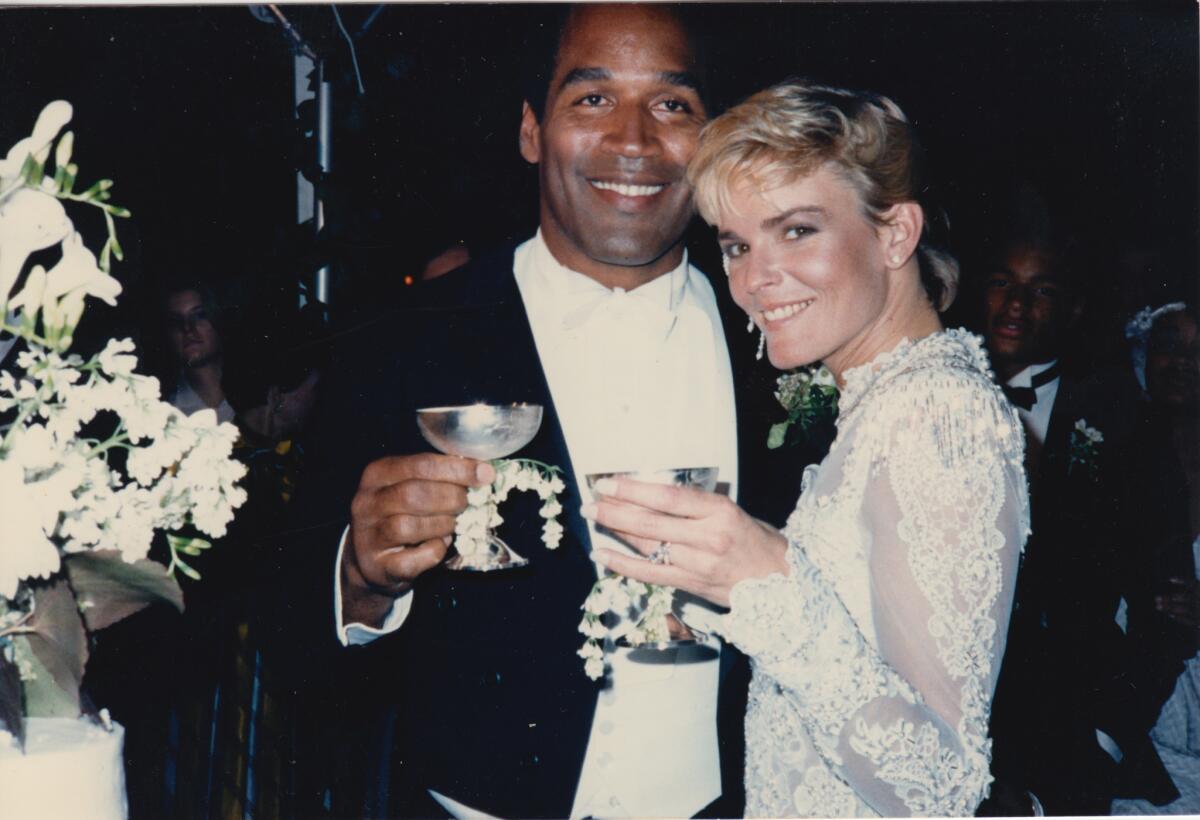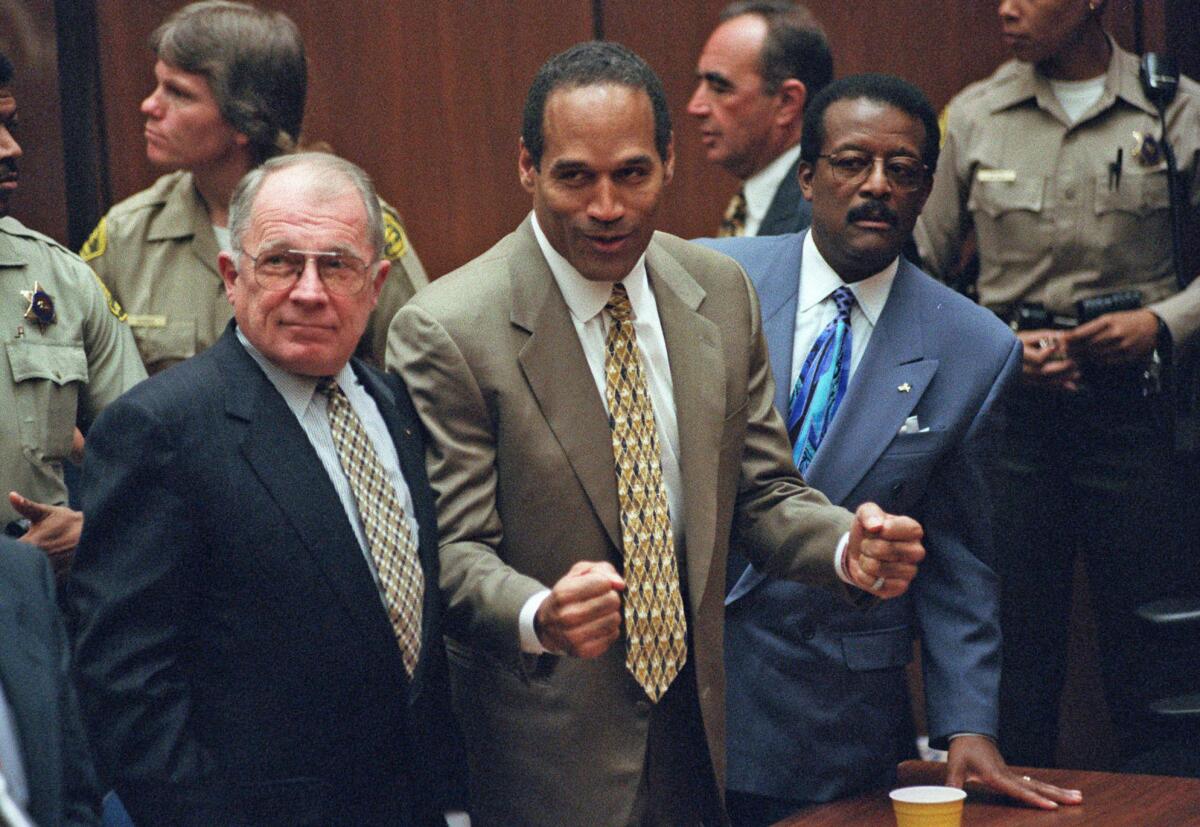Why ‘O.J.: Made in America’ might be the first television show to win an Oscar
Is ESPN’s 7 ½-hour documentary “O.J.: Made in America” a movie or TV? It premiered May 20 in theaters for filmgoers who wanted to experience all 464 minutes in one sitting. On June 11, the first of five episodes debuts on ABC. Will it win an Emmy? An Oscar? Both? With the once-clear lines between movies and TV getting ever-fuzzier, we asked TV critic MARY McNAMARA and film critic KENNETH TURAN to review “Made in America” from their perspectives. It’s just one part of The Blur, a special Los Angeles Times series examining why the medium is no longer the message.
Comedy, they say, is tragedy plus time. The same equation can also result in revelation, as ESPN’s astonishing documentary series “O.J.: Made in America” proves.
There have many attempts to tell the O.J. Simpson story, to explain why, in 1995, what appeared to be an open-and-shut case of domestic violence taken to its fatal and too-often inevitable conclusion turned into the trial of the century and resulted in acquittal. But all pale beside Ezra Edelman's 7 1/2-hour chronicle of Simpson's life and times.
Historically meticulous, thematically compelling and deeply human, “O.J.: Made in America” is a masterwork of scholarship, journalism and cinematic art.
-------------
For the record
7:56 p.m.: An earlier version of this article misstated the year of O.J. Simpson's murder trial as 1992. The trial ended in 1995.
-------------
And though it makes its debut theatrically in the hope of receiving an Oscar nomination, “Made in America” is also clearly built for TV. The five 90-minute episodes fit together seamlessly, making it a plausible film experience. But the ambition of the project requires time of the audience. Not just to watch, but to think; those approaching "Made in America" as just another queasily nostalgic pastiche of facts we already know risk being overwhelmed.

Edelman and his team use many tools — interviews with 72 people, mountains of archival film clips, court testimony and photographs — but literally and philosophically, he handles none more effectively than time.
Indeed, it is the key ingredient of the series, as the opening scene of an aging and subdued Simpson makes clear.
See the most-read stories in Entertainment this hour >>
Eight years into a 33-year prison sentence for armed robbery and kidnapping, Simpson is visibly diminished in body and mien. His story may continue to fascinate — Ryan Murphy recently turned the trial into a star-spangled night-time soap and at least one other documentary is in the works — but the figure describing daily life in prison seems more footnote than a central figure of history, controversy and national mythology.
Orenthal James Simpson is a man who has fallen out of his own story, and Edelman proceeds to show us exactly how.
'Made in America' is not the story of the Simpson trial; it’s the story of all the forces that created it. Simpson and his meteoric rise, but also Los Angeles.
— Mary McNamara
It’s been 22 years since Simpson was found not guilty of the brutal murder of his ex-wife Nicole Brown Simpson and her friend Ronald Goldman, 22 years since the “trial of the century” morphed from self-referential media circus into a stunning indictment of racist law enforcement in Los Angeles and racial division in the United States.
Certainly the intervening years grant both a wider perspective and emotional distance; the principal players interviewed here — including friends and family, attorneys from both sides, key witnesses, jury members and journalists — are able to discuss the events in a way that was simply not possible in the aftermath of the trial, and the frankness of some will take your breath away.

But “Made in America” is not the story of the Simpson trial; it’s the story of all the forces that created it. Simpson and his meteoric rise, but also Los Angeles and its troubled past.
It's easy, and accurate, to connect Simpson's acquittal to that of the police officers who viciously beat Rodney King and the riots that followed. But the notion of "payback" is far too simplistic. And to prove that, “Made in America” starts from scratch — Simpson as a boy, L.A. as the illusory promised land for black Americans fleeing the prejudice of the South. The details are so many and so revelatory, the crisscrossing themes so rich and illuminating, that the space between each episode becomes as important as the episode itself, a place to sit with what has just transpired.
FULL COVERAGE: The blur between movies and television
The first episode especially is a symphony of counterpoint, with Simpson’s life laid against the experience of black Los Angeles. Institutionalized police brutality sparks the Watts riots and continues long after. Simpson, a gifted athlete and radiant personality from the San Francisco projects is recruited to and embraced by the rich white bubble of USC — even as, blocks away, black men and women continue to be randomly arrested, beaten or killed. As No. 32 streaks past defensive linemen and grants interviews with personable humility, police regularly tear South Los Angeles homes and families apart.
Though many see O.J. as a breakthrough, a bridge between black America and white, he lives in a rarefied place separate from both.
“I’m not black, I’m not white, I’m O.J.” became his mantra. His allegiance was to his talent, his team, his career. Above even the roiling unavoidable politics of the time, he saw himself, and was seen by many, as exceptional.
Which he certainly was. Clip after clip of Simpson running the ball down the field all but defines poetry in motion; the footage of the famous 1967 face-off with UCLA will thrill even the most stubborn non-football fan, even knowing that far more significant events, including the assassination of Martin Luther King Jr. and Robert F. Kennedy loomed in the background.
So when former USC football players identify 1968 solely as the year USC won the consensus national championship (at 1968's Rose Bowl for the 1967 season) and O.J. the Heisman (for the 1968 season) while a montage of those horrific news events unfurls, the contrast is even more chilling because you understand why. The bubble was real.
That ability to show all sides of this history, to balance opposing forces and push them forward is what drives the whole series.
As we watch Simpson move through the professional years, the Hertz years and the film years, as he divorces his first wife and begins dating an 18-year-old waitress named Nicole Brown, it's difficult not to lean toward the trial's familiar drama, which is presented with the same clear-eyed thoroughness as the earlier episodes. If Nicole is, once again, discussed only in terms of her relationship with O.J., at least her plight as the victim of relentless physical and emotional abuse is given its due, as is the despair and determination of the Goldman family.
But the trial is just one part of the series, which continues through the years that led to Simpson's robbery conviction, 13 years to the day of his acquittal and "Made in America" is exactly what the title implies.
With the same sure-footed vision of the Juice running the ball down the field, it measures the long reach of racism, which created not just two separate cities and two separate nations, but also a man who had no peer in either.
‘O.J. Made in America’
Where: ABC and ESPN
When: 9 p.m. Saturday, June 11 (ABC); 9 p.m. Tuesday, Wednesday, Friday and Saturday, June 14-18 (ESPN)
MORE:
'O.J.: Made in America' is a movie so compelling you want it never to end ... even at 7-plus hours
Five films that were faced with the theatrical/streaming choice
To stream or not to stream: Filmmakers face a tough choice on getting their films to audiences
The complete guide to home viewing
Get Screen Gab for everything about the TV shows and streaming movies everyone’s talking about.
You may occasionally receive promotional content from the Los Angeles Times.




